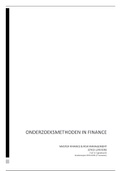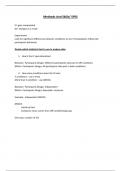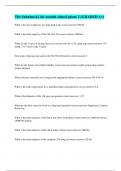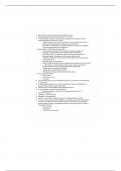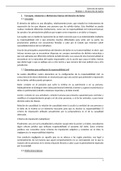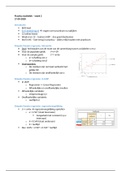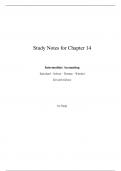MASTER FINANCE & RISK MANAGEMENT
JOYCE LEFEVERE
Prof. K. Inghelbrecht
Academiejaar 2019-2020 (1e semester)
,Deze lesnotites werden gemaakt tijdens de hoorcolleges van professor K. Inghelbrecht en
werden wegens tijdsgebrek niet aangevuld met boek of andere informatie. Ook typ- en
spellingsfouten werden er (nog) niet uitgehaald.
BIBLIOGRAFIE
Brooks, C. (2019). Introductory econometrics for finance. Fourth edition. Cambridge:
Cambridge University Press.
Inghelbrecht, K. (2019). Onderzoeksmethoden in Finance.
,J.L.
1. INTRODUCTION AND DEALING WITH DATA 1
Introduction 1
Purpose of Research Methods or Econometrics 1
General framework 2
Examples of problems that may be solved by an Econometrician 3
Some points to consider when reading papers in the academic finance literature 3
Types of financial data 4
Time Series Data + TIJDREEKSDATA and Frequency 4
Time Series versus Cross-sectional Data 5
Qualitative and quantitave data 5
Primary versus Secondary Data 5
Obtaining data 6
1- Eikon Datastream/Worldscope 6
2- Orbis 10
3- Orbis Financial Institutions 10
4- Bel-first 10
5- Zephyr 11
6- Free data sources 11
Dealing with data 12
Data transformations 12
Graphical methods 17
Descriptive statistics 19
Measures of Association: Correlation 24
Understanding Correlations 25
Why are Variables Correlated? 26
Correlation among several variables 28
Key Concepts 28
Summary 28
Course material 29
2. CLASSICAL LINEAR REGRESSION MODEL (CLRM) 31
Data Handling 31
Simple Regression 31
Introduction 31
An example 32
Theory 33
Interpretation of OLS Estimates Nonlinear Regression Models 40
Classical Linear Regression Model 43
Assumptions 43
Properties OLS Estimator Statistical Aspects of Regression 44
Statistical Inference 49
Hypothesis Testing 49
Probability Distribution of OLS Estimators 51
Test of Significance, Confidence Interval, t-ratio Type of Errors 52
ONDERZOEKSMETHODEN IN FINANCE |INHOUDSTAFEL (A)
, J.L.
Simple regression Model 67
Multiple regression 67
Interpretation of OLS estimates 68
Regression with qualitative/dummy variables 69
Simple regression with one Dummy Variable 70
Simple with Multiple Dummy Variables 71
Multiple regression
Goodness of Fitwith Dummy
Statistics andR-Square
Adjusted non-Dummy variable 72
Multiple regression with Interaction Dummy variable 73
2
Adjusted R
Goodness of Fit Statistics: R2 and adjusted R2 74
Residual Analysis 74
In orderR2to get around these problems, a modification is often made 74
which takes intocases:
The limit accountR2 = 0the
andloss
R2 =of
1 degrees of freedom associated 75
with adding extra variables. This is known as R̄ 2 , or adjusted R 2:
Testing on R 2
: F-test 76
Problems with R2 as a Goodness of Fit Measure 77
T 1
2 R̄ 2 = 1 (1 R 2)
Adjusted R = T k 77
Hedonic Pricing Models 78
A Regression Example: Hedonic House Pricing Models 2 78
So if we add an extra regressor, k increases and unless R increases by
Purpose of Research Methods2or Econometrics 80
a more than offsetting amount, R̄ will actually fall.
Keyare
There concepts
still problems with the criterion: 80
1 A “soft” rule (research will typically end up with large model)
Summary 81
2 R̄ 2 may take on negative values (when the model fits the data very
poorly)
3. CLRM ASSUMPTIONS AND DIAGNOSTIC TEST 83
Classical Linear Regression Model (CLRM): Assumption + Properties 83
Basisassumpties: 83
Properties 83
Violations or Pitfalls: 84
Investigating violations of assumptions of CLRM: 84
Assumption 1: E (ut ) ≠ 0 85
Assumption 2: Heteroskedasticity 87
Assumption 3: Residual autocorrelation 96
Assumption 4: Omitted variable bias 113
Assumption 5: ut is not normally distributed 119
Multicollinearity 123
Measurement errors 127
Spurious regression 128
Overview violations 131
Other pitfalls: overviews 133
Strategy for Constructing Model Application 134
General-to-Specific Approach 135
First step: Form a “large” model with lots of variables on the right hand side 135
Next step: Reparameterise the model by knocking out very insignificant regressors 135
Key concepts 136
Summary 136
ONDERZOEKSMETHODEN IN FINANCE |INHOUDSTAFEL (B)
,J.L.
5. RESEARCH PROJECT 139
Conducting Empirical Research 139
Examples of Possible Types of Research Project 139
A Good Project will: 139
Title page 140
Abstract 140
Introduction 141
Literature review 141
Data 142
Methodology 142
Results 142
Conclusion 143
References 143
Conducting Empirical Research 143
Introduction ‘Groepsopdracht’ 144
Guidelines 144
Title Assigment 144
Testing the CAPM 145
Problems in Testing the CAPM 149
The Fama-French Methodology = Fama-French 3-Factor Model 149
Groepsopdracht 152
Criteria for assestment 153
Course material 154
4. MODELLING LONG-RUN RELATIONSHIP IN FINANCE 155
Working with Time Series Data 155
Violations or Pitfalls in Regressions with Time Series Data 155
Non-stationarity 156
Motivation and Definition 156
Deterministic versus Stochastic non-stationarity 162
Definition of non-stationarity 162
Example: Stock Prices on the NYSE 162
Unit root testing: 164
How do we test for a unit root? 164
Dickey-Fuller test 165
DF critical values 166
Augmented Dickey-Fuller test = ADF Test 167
Cointegration 167
Introduction 167
Intuition 169
Test for Cointegration: DF test die met andere testwaarden is, dus Engle-Granger test 171
Error Correction Model ECM 174
Intuition 175
Model 175
Estimations of ECMs 175
General Form of an ECM 176
Example 176
ONDERZOEKSMETHODEN IN FINANCE |INHOUDSTAFEL (C)
,J.L.
Key Concepts 176
Summary 177
6. MULTIVARIATE MODELS 179
Why Multivariate Models? 179
Granger Causality 179
Granger causality in a dynamic model 181
Granger causality test 183
Granger causality: example 184
Causality in both directions 185
Granger causality : example 186
Vector autoregressions (VAR) 188
Motivation 188
Notation and concepts 189
Estimation of vector autoregressions 189
Why use VARs? 190
Lag length selection 191
Forecasting with VARs 193
VARs: (1) Impulse responses 195
(2) Variance decomposition 196
Example 196
Summary 199
7. MODELS FOR PANEL DATA 201
Types of financial data 201
Examples of panel data 201
Why panel data? 202
Example 203
Example: individual regressions 203
Types of models for panel data 204
1. Pooled model 204
2. Individual effects models 207
Fixed or random effects model: Hausman test 216
Example: Random Effects Model 217
Estimating panel data models: Steps to follow 218
Panel data models and nonstationary variables (niet te kennen) 218
Example: unit roots test for nonstationary variables 219
Extensions to individual effects model 219
Example: Credit Stability of Banks in C/E Europe 220
Key Concepts and Summary 222
ONDERZOEKSMETHODEN IN FINANCE |INHOUDSTAFEL (D)
,J.L.
8. LIMITED DEPENDENT VARIABLE MODELS 225
Qualitative Choice Models 225
Motivation 225
Linear Probability Model 226
Solution 1: Logit Model 228
Solution 2: Probit Model 229
Ordered Probit Model 237
Key concepts and summary 238
9. EVENT STUDY ANALYSIS – EVENT STUDIES IN FINANCE 239
Outline of an event study 239
Example of an event study: Earnings Announcements 241
Models for measuring normal performance 242
Computing abnormal return 242
Constant mean return model 242
Market model 243
Example: Earnings Announcements 243
Measuring and analyzing abnormal returns 244
Estimation market model 244
Computing abnormal returns 244
Statistical properties of abnormal returns 244
Testing for significant abnormal returns 245
Aggregation of abnormal returns 245
Example: Earnings Announcements 248
Cross-sectional regressions 250
Use of dummies in event studies 251
Key Concepts and Summary 252
ONDERZOEKSMETHODEN IN FINANCE |INHOUDSTAFEL (E)
,
,J.L.
DOELSTELLINGEN
Het doel van deze cursus is om de studenten vertrouwd te maken met het verzamelen, het
analyseren en het modelleren van financiële data.
1. Aanleren standaard econometrische technieken typisch toegepast op financiële data
2. Vertrouwd maken met belangrijkste databanken
3. Aanleren hoe eenvoudig data kan geanalyseerd worden aan de hand van standaard
econometrisch software pakket ‘Gretl’ (eventueel ook Excel)
GROEPSOPDRACHT
De groepsopdracht bestaat erin om de econometrische technieken die aangeleerd werden in
deze cursus toe te passen op een financiële dataset en de resultaten ervan te rapporteren in
een wetenschappelijk document van maximum 6 pagina’s. De details van de
groepsopdracht worden bekend gemaakt in de les van 23/10 en zullen ook via Minerva
kenbaar gemaakt worden. De groepsopdracht moet ingediend worden ten laatste op 15/11.
Er wordt gewerkt in groepen van 5. De groepen worden at random samengesteld. De
beoordeling gebeurt gedeeltelijk via peer evaluation. De student kan met vragen en
problemen bij de docenten terecht voor, tijdens of na de colleges.
EVALUATIE
Schriftelijk examen via PC/Gretl (70%) en groepswerk met peer evaluation (30%).
Het schriftelijk examen wordt opgelost gebruik makend van een standaard econometrisch
software pakket. Het werkstuk wordt beoordeeld door de titularis en door de groepsleden
aan de hand van een peer-evaluatie. à 2 grote opdrachten (16p) + 2 opvragen op 4p voor
algemen vragen die kijken naar intuïtie van de theorie
- 4 punten: naar theoretische inzitchten
- 16p: vanuit een excel bestand via gretl enkele econometrische analyses uitvoeren en
die resultaten bespreken (t-waarde, p-waarde, significant, testen voor
heteroscedasticiteit en autocorrelatie → test neerschrijven, resultaat en eventuele
oplossingen)
Eindscoreberekening: De student dient geslaagd te zijn voor alle onderdelen om te kunnen
slagen voor het vak. Indien de student niet geslaagd is voor een onderdeel en het
mathematisch gemiddelde een cijfer van 10 of meer op 20 oplevert, wordt dit teruggebracht
tot 9/20, het hoogst niet geslaagd cijfer.
De student dient deel te nemen aan alle onderdelen van de periodegebonden en niet-
periodegebonden evaluaties om te kunnen slagen voor dit opeidingsonderdeel. Indien een
student zich onttrekt aan onderdelen van de periodegebonden en/of niet periodegebonden
evaluaties dan wordt de eindscore (indien hoger dan 7/20) herleid tot het hoogste niet-
tolereerbaar cijfer (7/20).
Tweede examenperiode: Afhankelijk van de tekorten een schriftelijk examen en/of een
individueel werk. De punten van het onderdeel waarvoor geslaagd in 1ste zittijd worden
overgenomen naar de 2de zittijd.
ONDERWIJSVORMEN
Theorie in de les, niet in week 8 en week 12
Oefeningen is via lesopnames
, J.L.
GROEPSOPDRACHT
Onderzoeksvraag oplossen
Met 5, at random gekozen
Peer evaluation: elkaars inzet evalueren
OVERVIEW
1. Introduction and Dealing with Data
2. Classical Linear Regression Model (CLRM)
3. CLRM Assumptions and Diagnostic Tests
4. Modeling Long-Run Relationships in Finance
5. Research Project
6. Multivariate Models
7. Panel Data
8. Limited Dependent Variable Models
9. Event Studies
10. Modeling Volatility and Correlation
ONLINE COMPUTER SESSIONS
1. Gretl, Dealing with Data and Simple Regression
2. Multiple Regression and Diagnostic Tests for Cross-Sectional Data
3. Diagnostic Tests for Time Series Data
4. Modelling Long-Run Relationships in Finance
5. Multivariate Models
6. Models for Panel Data
7. Limited Dependent Variable Models
8. Event Study Analysis


